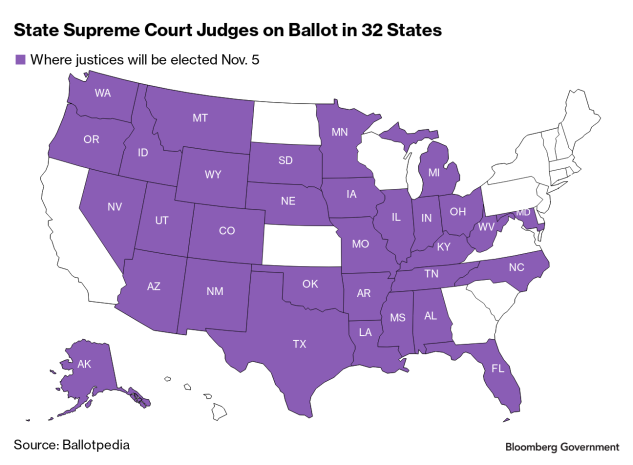Most would restore pre-Dobbs protections, but some advocates want to go further.
ByMonica Potts
October 28, 2024, 11:24 AM
"In 2022, protecting abortion rights was a winning issue in the six states that saw ballot initiatives related to abortion:
- That year, voters in the red states of Kansas, Kentucky and Montana rejected measures that would have restricted or removed existing protections for abortion access in those states, while
- voters in California, Michigan and Vermont approved measures that enshrined access to abortion in their states’ constitutions.
- In 2023, Ohio joined them.
- Next week, 11 more abortion-related initiatives will be on voters’ ballots — nine of them focused on restoring the right to abortion in individual states, one rival measure in Nebraska that would prohibit that right and one in New York that would expand the state’s anti-discrimination laws to include reproductive health protections.
It’s the largest and latest push after the Supreme Court’s decision in Dobbs v. Jackson Women’s Health Organization upended abortion politics in the summer of 2022 and left in place a patchwork of state-specific abortion protections and restrictions.
Though they vary somewhat, most state initiatives this year are seeking to restore the protections that were in place before the Dobbs decision under Roe v. Wade — and updated under Planned Parenthood v. Casey — which guaranteed the right to abortion before the point of "fetal viability." Since 2022, many Democrats — including Vice President Kamala Harris, whose full-throated support for abortion rights has been a centerpiece of her presidential campaign — have focused on "restoring Roe." For example, Harris said last month that she would support "eliminat[ing] the filibuster for Roe," so a Democratic majority in Congress could "put back in law the protections for reproductive freedom, and for the ability of every person and every woman to make decisions about their own body and not have their government tell them what to do."
But while her message on individuals’ rights to make health care decisions without government interference echoes a common refrain of abortion-rights advocates, some also say that simply restoring Roe is not enough, pointing out that many women struggled to access abortion care even before Dobbs. Polling since Dobbs has shown that there might be some support for this among voters.
Arizona, Florida, Missouri, Montana, Nebraska and Nevada will all have measures on the ballot next week that would guarantee the right to abortion until the point of fetal viability — generally defined as the point at which most experts say a fetus could survive outside the womb, and often considered to be around 24 weeks of pregnancy:
- Whether a fetus can survive outside of the womb depends on a number of factors.
- Moreover, this standard, which centers on the life and health of the fetus, still led to high maternal mortality rates, particularly in states that had more restrictions
- In an AP/NORC poll from June 2021, before the Dobbs decision, 61 percent of respondents thought abortion should be legal in all or most cases during the first trimester, but that dropped to 34 percent in the second and 19 percent in the third trimester.
- Annual AP/NORC polls since then showed similar results using a timeline more aligned with many ballot measures this year:
While those numbers were fairly stable over the last couple years, regular Gallup polling has shown a small but sustained rise in the number of Americans who think that abortion should be legal under "any" circumstances, from under 30 percent in most surveys before the Dobbs decision, to 35 percent this May. .
Only about 1 percent of abortions are estimated to occur at or after 21 weeks of pregnancy, and the vast majority of them are necessary for the health of the pregnant person, or are the result of fatal fetal abnormalities, meaning that a fetus will never be viable. And even though states that prohibit later-term abortions often allow for exceptions in cases like these, advocates point out that restrictions have made them very difficult to obtain.
. . .Ashley Kirzinger, an associate director of public opinion and survey research at KFF, a nonprofit health policy research organization, pointed out that it wouldn’t work for most politicians nationwide to campaign on abortion rights without restrictions for later pregnancies. "[Voters] want abortion access, but they want it with limitations," she said. "If [candidates] were campaigning on broader abortion access, they would be painted as ‘abortion without limitations,’ which is not where the majority of the electorate is.”
That raises a concern for advocates of expansive abortion protections: While education about the inexactness of terms like "fetal viability" may help change voters’ minds, distortions from the other side, like the falsehood repeated by former President Donald Trump that some states allow abortions "after birth," have proven particularly resonant.
Kelly Hall, executive director of the Fairness Project, a ballot-initiative organization that has helped with the Arizona, Florida, Missouri, Montana and Nebraska initiatives to protect abortion rights, said that state initiatives were driven by activists on the ground who were advocating for the kinds of initiatives they think can pass in their states, and they chose to add viability cutoffs to the ballot measures. "[It’s not that] one set of decision makers made a universal set of choices about how to approach this across the country," she said. "It really has been driven by local advocates who have a variety of views."
Lee-Gilmore, on the other hand, thinks those ideas are driven by out-of-date public opinion research that took the Roe status quo for granted. "People's values right now in America … are that they believe these are personal decisions, that the government doesn't belong," she said.
While it’s unclear whether abortion-rights ballot measures will help Democrats all that much at the ballot boxes next week, abortion remains a salient issue among their base.
- Some data suggests that Democratic women particularly have been more motivated to vote since Harris moved to the top of the ticket.
- If they help propel Harris and the Democrats to a win, the party will surely prioritize shoring up protections for abortion access.








No comments:
Post a Comment